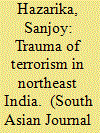| Srl | Item |
| 1 |
ID:
126219


|
|
|
|
|
| Publication |
2012.
|
| Summary/Abstract |
Effective communication and coordination are critical when investigating a possible drinking water contamination incident. A contamination warning system is designed to detect water contamination by initiating a coordinated, effective response to mitigate significant public health and economic consequences. This article describes historical communication barriers during water contamination incidents and discusses how these barriers were overcome through the public health surveillance component of the Cincinnati Drinking Water Contamination Warning System, referred to as the "Cincinnati Pilot." By enhancing partnerships in the public health surveillance component of the Cincinnati Pilot, information silos that existed in each organization were replaced with interagency information depots that facilitated effective decision making.
|
|
|
|
|
|
|
|
|
|
|
|
|
|
|
|
| 2 |
ID:
121108


|
|
|
|
|
| Publication |
2013.
|
| Summary/Abstract |
This paper presents the experiences of 22 displaced families and their battle for water access based on a pilot survey of Manesar, in the northern Indian state of Haryana. Interviews were conducted in the summer of 2011 to examine a water regime recently transformed by compulsory land acquisition and displacement in one of India's driest and fastest growing areas. This dimension of the land acquisition and displacement narrative is a response to the crisis over resource access and control in peri-urban India where a burgeoning demand for land, water, and capital has sparked contentious debates over fairness and equity. Despite recent amendments to the Land Acquisition Act of 1894, long-standing questions regarding compensation and rehabilitation for drinking water services remain unanswered. The findings of this paper show that there may be limits to halting the effects of land displacement altogether without aggressive legislation capping water grabs, or a radical shift in the way in which water is valued and redistributed to the landless. Conventional alternatives to fulfilling drinking water needs, designed by and for the less poor, such as bottled water, private water tankers, water permit systems, or even land redistribution are likely to exacerbate already limited access, rather than improve it. A number of mitigation techniques are explored, including those inherent to common property resources (CPR), which may ensure access to safe drinking water is maintained.
|
|
|
|
|
|
|
|
|
|
|
|
|
|
|
|
| 3 |
ID:
122383


|
|
|